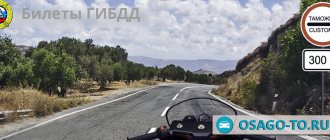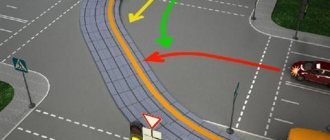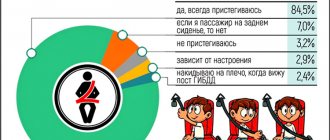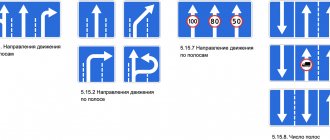What is a safety island and what are they?
According to the rules, a traffic island is a part of the road; it separates traffic lanes or, conversely, indicates their merging. Sometimes a traffic island is part of a pedestrian crossing. A pedestrian stops there to cross the road.
Islands are marked with markings and borders.
Island with markings. There are three options for marking an island using markings: to separate opposite lanes, separate and merge two streams of cars in one direction.
Island border. With its help, road services help pedestrians cross a multi-lane road.
Marking 1.16.1 separates opposite lanes. Source: rg.ru
Markup 1.16.2 separates traffic flows
Markup 1.16.3 merges two streams into one
Yellow posts stand on a hill with a curb - this is a safety island
Is it allowed to park (stand) on this section of the road, according to traffic regulations?
The traffic rules contain an exclusive list of road sections on which stopping and, accordingly, parking are strictly prohibited. There is no island of safety among them.
But it is worth remembering that these markings are applied to the zebra crossing, intended for pedestrians to cross the road, as well as to separate traffic flows. In the first case, they are intended for use in situations where a pedestrian does not have time to cross the road when the green light is on.
The photo shows the markings:
when dividing traffic flow 1.16.1
By stopping or leaving the car on this section of the road, the motorist will violate the traffic rules, where stopping and parking of vehicles at pedestrian crossings is not allowed (Read more about the fine for parking at a pedestrian crossing here).
Also, such islands are provided to separate traffic flows. If you refer to clause 12.4 of the traffic rules, you can read that it is prohibited to stop the vehicle in the area where roadways intersect , as well as closer than five meters from the edge of the intersection. In cases where there is a traffic island in these areas, stopping on it will be equivalent to this violation.
In cases where the markings are located outside the intersection, the prohibition on stopping and parking also remains. And here it is worth turning to the Rules of the Road, namely, paragraph 12.1, which allows the above actions on the right side of the road on the side of the road, and in its absence, at the edge of the roadway.
In populated areas, stopping and parking on the left side is allowed in single-lane traffic. But nowhere in the rules does it say that you can park a vehicle between oncoming lanes.
The photo shows markup 1.1:
Is it possible to avoid paying a fine for driving on an island?
It happens that the video recording camera made a mistake and incorrectly recorded a violation. This happens with Strelka-ST camera models. To give the driver a better chance of challenging the fine, it is better to use a DVR. Read about how to challenge fines from the State Traffic Safety Inspectorate, MADI or AMPP in our other article.
If the driver does not agree with the inspector’s decision, he can appeal it within 10 days. If the traffic police cancels the fine, you won’t have to pay.
In all other cases, this will have to be done, otherwise 70 days after the violation the fine will be handed over to the bailiffs. After this, the bailiffs will begin enforcement proceedings and assign an enforcement fee - 1000 rubles, or 7% of the fine. If you continue to not pay, the case will be taken to court and the money will be withdrawn from your bank account.
What to do if the case is already with the bailiffs or the money was withdrawn twice, read our analysis about the FSSP.
Is it possible to stop at a traffic island 2021
Traffic police officers often fine drivers not only for parking on traffic islands, but even simply for driving on them. In fact, this is not entirely legal, but for some reason drivers are in no hurry to challenge fines for this.
There are two typical situations when a driver is fined for having his car on a traffic island: for parking on it and for driving through it. As for parking, in each case you need to look at what kind of “island” it is. Appropriate markings can be placed on the asphalt in the middle of the street, at a pedestrian crossing (so they can wait until the green light turns on again), at an intersection so that cars follow the correct trajectories, as well as in places where traffic flows merge/divide on a multi-lane road. If a citizen decides to park his car on a traffic island intended for pedestrians, he will most likely end up right in the zebra crossing zone. For this case, the Code of Administrative Offenses has a special article - 12.19 (violation of parking and stopping rules). She promises a 1000 ruble fine for “transition”. And in general, they can evacuate. In the case when the “safety island” chosen by a citizen for parking is located at the “intersection of roadways” - within the intersection, that is, the law no longer allows him to evacuate his car. Here he faces only a fine (still according to the same 12.19) - but only 500 rubles. The most ambiguous parking option is within an “island”, which is located at a junction or separation of traffic flows, but not at an intersection. There are plenty of such striped patches of asphalt at exits and entrances not only to highways, but also to more or less large streets and traffic intersections in general.
Note that in these places drivers are actively fined not only for parking, but also simply for driving through the “island” - in the capital, for example, there are several cameras for automatically recording violations aimed exclusively at “cutting off” fines for driving through this kind of white stripes on the asphalt. They are fined for both of these violations under the same article of the Code of Administrative Offenses - 12.16, for failure to comply with the requirements prescribed by road signs or markings. Fine - 500 rubles. Penalties of this kind usually state that the driver violated the requirements of paragraph 1.16.2 of Appendix 2 to the traffic rules. But if you read this very paragraph 1.16.2, it turns out that such markings, in fact, do not require or instruct the driver to do anything, but just, quote, “indicate islands separating traffic flows in the same direction.” That is, in fact, driving through such an “island” is not a violation in principle from the point of view of traffic rules. If you need to be fined for parking in such a place, it will certainly not be under the article on violation of marking requirements, which, in fact, does not exist. Here, for example, you can find the offense for paragraph 3.2 of Article 12.19 of the Code of Administrative Offenses - “stopping or parking vehicles further than the first row from the edge of the roadway,” which implies 1,500 rubles and allows the car to be towed to an impound lot.
In almost all cities there is a rush hour, during which the roads are crowded with cars and it is impossible to find a parking space. Some car owners in such situations stop almost anywhere they want, and one of such places is traffic islands. Let's figure out what the fine is for entering a traffic island in 2021, and is it possible to stop in this zone?
How to receive notifications on time to pay a fine at a discount
It happens that due to a large influx of visitors, electronic services work with malfunctions or a long delay. This was the case when the president signed a decree on child benefits in June 2021. Parents began to process payments through government resources and overloaded the server. There was no access to other services, such as checking fines, for a long time.
In order not to depend on force majeure, subscribe to the traffic police fines notifications. The service takes information directly from the GIS GMP database. All duties, fines and taxes in favor of the state pass through it.
Stipulated punishment for violating traffic rules for drivers
Hitting, stopping or parking on a traffic island is punishable under two articles of the Code of Administrative Offenses of the Russian Federation - 12.16 and 12.19. According to them, the violator faces:
- for driving or hitting one wheel - a warning or a fine of 500 rubles;
- for stopping or parking - a fine of 500 rubles. In Moscow and St. Petersburg, the amount of monetary penalties has been increased to 2,500 rubles.
A safety island is not only a continuation of a pedestrian crossing, but also a special marking on the roadway designed to regulate flows. A strict rule that all drivers should remember is that stopping and, especially, parking in this zone is prohibited.
A traffic island is a fairly new element of road design that separates traffic lanes in opposite directions and serves as an element of protection for pedestrians when crossing the roadway.
Unfortunately, little is written about it in the Road Traffic Rules. But there is nothing at all in the Code of Administrative Offenses of the Russian Federation. Motorists and traffic police officers constantly argue about responsibility for hitting or stopping a vehicle in a given area.
- What it is?
- What does it look like on the road and what is it used for?
- What is the fine and/or other punishment for driving on this road sign?
- Is it possible to drive into it and what will happen if it is driven over?
- Is it allowed to run over when turning or turning?
- Stopping and parking on the triangle
- Traffic rules requirements
- Controversial situations when crossing road markings
- How can you prove the guilt of a car driver?
- Conclusion
Remember
- A safety island is made by markings or by raising it above the road.
- The island is needed to separate traffic flows and protect pedestrians on the wide road.
- The fine for crossing or turning around on an island is 500 rubles.
- The fine for stopping or parking on an island is 1,000 rubles.
- If the fine is not paid within 70 days, the fine will be handed over to the bailiffs, who will write off the amount of the fine from the account.
- To receive notifications about fines on time and pay fines at a discount, subscribe to notifications on the Traffic Police Fines website.
Author: Evgeny Lesnov
Is it possible to stop on traffic islands?
Driving on the lanes is strictly regulated by the rules. The solid white line has been legally turned into a taboo. Under penalty of deprivation of your driver's license, driving behind it is prohibited, especially when overtaking on two-lane roads. But what if the lanes are separated by a “safety island”?
Oddly enough, the term “safety island” is not well defined in the traffic rules. This is not an oncoming road or a shoulder, but a neutral space, isolated from vehicle traffic by white stripes. The island is indicated by slanted white stripes. And if you carefully read the rules, there is no prohibition on stopping inside these spaces. This is what the text of clause 12.4 says:
- “Stopping is prohibited on tram tracks, as well as in the immediate vicinity of them, if this will interfere with the movement of trams;
- at railway crossings, in tunnels, as well as on overpasses, bridges, overpasses (if there are less than three lanes for traffic in a given direction) and under them;
- in places where the distance between a solid marking line (except indicating the edge of the roadway), a dividing strip or the opposite edge of the roadway and a stopped vehicle is less than 3 m;
- at pedestrian crossings and closer than 5 m in front of them;
- on the roadway near dangerous turns and convex breaks in the longitudinal profile of the road when the visibility of the road is less than 100 m in at least one direction;
- at the intersection of roadways and closer than 5 m from the edge of the roadway being crossed, with the exception of the side opposite the side passage of three-way intersections (crossroads) that have a continuous marking line or dividing strip;
- closer than 15 meters from the stopping places of fixed-route vehicles or parking for passenger taxis, indicated by marking 1.17, and in its absence - from the sign of the stopping place of fixed-route vehicles or parking for passenger taxis (except for stops for boarding and disembarking passengers, if this does not interfere with the movement of fixed-route vehicles vehicles or vehicles used as passenger taxis);
- in places where the vehicle will block traffic lights, road signs from other drivers, or make it impossible for other vehicles to move (enter or leave), or interfere with the movement of pedestrians.
- in the bike lane."
In other words, we do not see a direct ban on stopping at a “safety island”. And if you can stop, then the question arises as to how long you are allowed to stand there. The rules state that parking is considered such if the car remains motionless for more than 5 minutes. But many manage to leave their cars for a much longer period, turning part of the road into a parking lot.
Most often, islands are drawn near roundabouts or at other complex lane intersections. And cars abandoned by drivers in such places often block the view of other road users.
To combat not only parking, but also stopping at the traffic police offices, it was decided to use the universal clause of traffic rules 12.16 part 1. “Failure to comply with the requirements prescribed by road signs or road markings.” A fine of 500 rubles is imposed for crossing any solid line.
Such punishment is usually prescribed to drivers who dare to cross neutral zones of roads.
Penalty for entering, stopping and crossing a traffic island
This is where the main differences and difficulties begin. We have already clarified one problem - crossing a continuous strip (violation of markings - Part 1 of Article 12.16 of the Administrative Code). We will return to sanctions on it later, but for now we will consider other possible violations:
- Is it possible to park on a traffic island? Let us remember that the island is directly connected to the pedestrian crossing. stopping/parking (parking) on a pedestrian crossing (Parts 3 and 6 of Article 12.19 of the Code of Administrative Offenses), can be recognized as a second violation
- At the same time, sanctions may well be applied for parking “further than the right lane ,” which is provided for in Part 3.2 of the same article.
- Article 8.1 of the Russian Traffic Regulations prohibits turning around at a pedestrian crossing . Part 2 Art. 12.14 of the Code of Administrative Offenses of the Russian Federation establishes a fine for this (we’ll return to the exact figures below).
- Article 11.4 of the Russian Federation Traffic Regulations completely prohibits overtaking at a pedestrian crossing . These are relatively recent changes in the rules, and the Code of Administrative Offenses has not yet identified an exact article for the case. However, depending on the circumstances, either the already mentioned violation of markings (Part 1 of Article 12.16 of the Code of Administrative Offenses) or driving into oncoming traffic (Part 4 of Article 12.15 of the Code of Administrative Offenses) is applied.
The amount of fines depends on these conditions. Basically they are like this:
| Violation | Fine | Note |
| Violation of markings (Part 1 of Article 12.16 of the Administrative Code) | 500 rub. | This is how driving onto a traffic island can be interpreted, as well as the minimum penalty for overtaking on the traffic island. |
| Stopping/parking at a crossing (Part 3 of Article 12.19 of the Administrative Code) | 1,000 rub. | Attention: in case of similar violations that occurred in Moscow or St. Petersburg, Part 6 of this article applies - the fine will be 3,000 rubles. |
| Stop/parking “further than the first rad” (Part 3.2 of Article 12.19 of the Code of Administrative Offenses) | 1500 rub. | |
| U-turn at a zebra crossing (Part 2 of Article 12.14 of the Administrative Code) | 500 rub. | A U-turn on a traffic island can be equated to this. |
| Driving into the oncoming lane (Part 4 of Article 12.15 of the Administrative Code). | 5000 rub. or deprivation of rights for up to six months | In this way, the worst-case scenario for overtaking on a traffic island can be interpreted. |
In addition, in some circumstances, a cumulative method of punishment for several articles may be applied.
You need to understand that it is allowed to stop at the markings in the event of a technical malfunction of the vehicle or poor health of the driver.
What is the fine and/or other punishment for driving on this road sign?
The Code of Administrative Offenses of the Russian Federation does not contain any directly prescribed punishment for traveling to a safety island. And on many websites you can read that holding a driver liable for hitting a traffic island has no legal basis. In reality this is not the case.
So is it possible to cross the islands? Our experts from the Legal.Center website have figured out this issue and are ready to give an answer.
Is it possible to drive into it and what will happen if it is driven over?
Entry to the traffic island 1.16.1 - 1.16.3 is possible only in emergency situations - car breakdown, unexpected stop due to breakdown, entry to avoid an accident, etc. situations. In all other cases, it will not be possible to avoid a fine.
The driver who ran into this road sign will be punished under Part 1 of Art. 12.16 Code of Administrative Offenses of the Russian Federation. If detected by an automatic fixation camera, the owner of the car will be fined 500 rubles. If a violation was discovered by a traffic police inspector, punishment in the form of a warning or a fine of 500 rubles is possible.
Many motorists will not agree with this punishment. Therefore, we asked the expert to comment on why liability is provided under this article.
Expert opinion Alexander Moskal Many years of experience in all areas of jurisprudence Let us turn to the above-mentioned National Standard of the Russian Federation GOST R 52766-2007. Paragraph 4.2.5.6 indicates that when placing an island on the roadway in front of it, a continuous inclined marking line 1.1 according to GOST R 51256 is applied on both sides, diverting traffic flows from the island (transition line), with an inclination to the road axis of 1:20 (1: 50).
As you know, road markings 1.1 are a solid line. And crossing a solid marking line is prohibited by traffic rules and is punishable in accordance with Part 1 of Art. 12.16 Code of Administrative Offenses of the Russian Federation.
×
The photo shows continuous marking 1.1:
Is it allowed to run over when turning or turning?
Crossing the traffic island when turning or turning is also prohibited. However, in this case, a violation can be issued under Part 2 of Art. 12.16. If detected by a camera, a fine of 1,000 rubles is imposed. If a violation was discovered by a traffic police officer - 1000 - 1500 rubles.
Stopping and parking on the triangle
This is the most confusing situation. In theory, the fine should be issued in accordance with Part 3 of Art. 12.19 Code of Administrative Offenses of the Russian Federation. Its size will be 1000 rubles. According to this article, parking is prohibited, since these markings are not intended for the movement and stopping of vehicles. On the traffic island, which is part of the zebra crossing, stopping and parking is strictly prohibited. Within the scope of a pedestrian crossing, a 10-meter zone on both sides is also not intended for these purposes.
In practice, sometimes traffic police officers issue a fine based on Part 4 and Part 5 of Art. 12.16. Administrative liability for these parts is 1,500 rubles or 3,000 rubles (for federal cities - Moscow and St. Petersburg).









